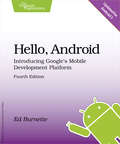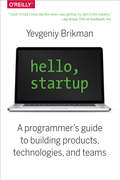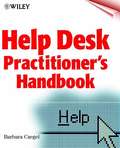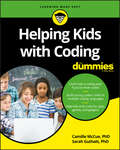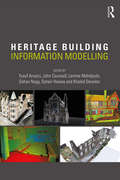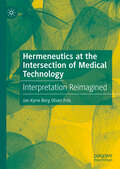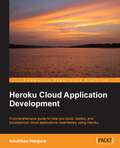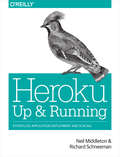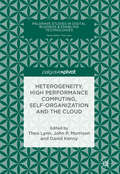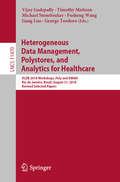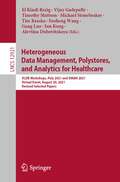- Table View
- List View
Hello, Android: Introducing Google's Mobile Development Platform
by Ed BurnetteGoogle Android dominates the mobile market, and by targeting Android, your apps can run on most of the phones and tablets in the world. This new fourth edition of the #1 book for learning Android covers all modern Android versions from Android 4.1 through Android 5.0. Freshly added material covers new Android features such as Fragments and Google Play Services. Android is a platform you can't afford not to learn, and this book gets you started.Android is a software toolkit for mobile phones and tablets, created by Google. It's inside more than a billion devices, making Android the number one platform for application developers. Your own app could be running on all those devices!Getting started developing with Android is easy. You don't even need access to an Android phone, just a computer where you can install the Android SDK and the emulator that comes with it. Within minutes, Hello, Android gets you creating your first working application: Android's version of "Hello, World." From there, you'll build up a more substantial example: an Ultimate Tic-Tac-Toe game. By gradually adding features to the game, you'll learn about many aspects of Android programming, such as creating animated user interfaces, playing music and sound effects, building location-based services (including GPS and cell-tower triangulation), and accessing web services. You'll also learn how to publish your applications to the Google Play Store.This fourth edition of the bestselling Android classic has been revised for Android 4.1-4.3 (Jelly Bean), 4.4 (KitKat), and Android 5.0 (Lollipop). Topics have been streamlined and simplified based on reader feedback, and every page and example has been reviewed and updated for compatibility with the latest versions of Android.If you'd rather be coding than reading about coding, this book is for you.
Hello, Startup
by Yevgeniy BrikmanThis book is the "Hello, World" tutorial for building products, technologies, and teams in a startup environment. It's based on the experiences of the author, Yevgeniy (Jim) Brikman, as well as interviews with programmers from some of the most successful startups of the last decade, including Google, Facebook, LinkedIn, Twitter, GitHub, Stripe, Instagram, AdMob, Pinterest, and many others.Hello, Startup is a practical, how-to guide that consists of three parts: Products, Technologies, and Teams. Although at its core, this is a book for programmers, by programmers, only Part II (Technologies) is significantly technical, while the rest should be accessible to technical and non-technical audiences alike.If you're at all interested in startups--whether you're a programmer at the beginning of your career, a seasoned developer bored with large company politics, or a manager looking to motivate your engineers--this book is for you.
Hello, Startup: A Programmer's Guide to Building Products, Technologies, and Teams
by Yevgeniy BrikmanThis book is the "Hello, World" tutorial for building products, technologies, and teams in a startup environment. It's based on the experiences of the author, Yevgeniy (Jim) Brikman, as well as interviews with programmers from some of the most successful startups of the last decade, including Google, Facebook, LinkedIn, Twitter, GitHub, Stripe, Instagram, AdMob, Pinterest, and many others.Hello, Startup is a practical, how-to guide that consists of three parts: Products, Technologies, and Teams. Although at its core, this is a book for programmers, by programmers, only Part II (Technologies) is significantly technical, while the rest should be accessible to technical and non-technical audiences alike.If you’re at all interested in startups—whether you’re a programmer at the beginning of your career, a seasoned developer bored with large company politics, or a manager looking to motivate your engineers—this book is for you.
Help Desk Practitioner's Handbook
by Barbara CzegelYour complete guide to surviving and thriving as a Help Desk practitioner Help Desk Practitioner's Handbook The only book to address the unique concerns of the huge and growing number of Help Desk analysts, this is your complete guide to becoming a more effective communicator and problem-solver and deriving greater satisfaction from your job. Barbara Czegel, North America's most well-known expert on Help Desk support services and training, uses dozens of fascinating scenarios and real-world examples to illustrate the right (and wrong) ways to handle virtually every situation you can encounter. She arms you with an arsenal of proven tools of the trade, including: * Eleven effective listening habits that improve your ability to solve problems * Techniques for increasing the speed and accuracy of problem resolution * Early warning systems and layered strategies for problem control * Tools for reducing calls and eliminating problems before they occur * A simple, step-by-step process for doing cost justifications * Methods for turning Help Desk interactions into marketing opportunities Visit our Web site at www. wiley. com/compbooks/
Help Your Kids with Computer Science (DK Help Your Kids)
by DKFrom coding languages and hardware to cyberbullying and gaming, this comprehensive homework helper for kids and parents covers the essentials of computer science. This unique visual study guide examines the technical aspects of computers, such as how they function, the latest digital devices and software, and how the Internet works. It also builds the confidence of parents and kids when facing challenges such as staying safe online, digital etiquette, and how to navigate the potential pitfalls of social media. Jargon-free language helps to explain difficult and potentially dread-inducing homework such as hacking, "big data" and malware, while colorful graphics help makes learning about the world of computer science exciting. Whether at home or school, this clear and helpful guide to computer science is the tool you need to be able to support students with confidence. Series Overview: DK's bestselling Help Your Kids With series contains crystal-clear visual breakdowns of important subjects. Simple graphics and jargon-free text are key to making this series a user-friendly resource for frustrated parents who want to help their children get the most out of school.
Helping Kids with Coding For Dummies
by Camille McCue GuthalsHelp for grown-ups new to coding Getting a jump on learning how coding makes technology work is essential to prepare kids for the future. Unfortunately, many parents, teachers, and mentors didn't learn the unique logic and language of coding in school. Helping Kids with Coding For Dummies comes to the rescue. It breaks beginning coding into easy-to-understand language so you can help a child with coding homework, supplement an existing coding curriculum, or have fun learning with your favorite kid. The demand to have younger students learn coding has increased in recent years as the demand for trained coders has far exceeded the supply of coders. Luckily, this fun and accessible book makes it a snap to learn the skills necessary to help youngsters develop into proud, capable coders! Help with coding homework or enhance a coding curriculum Get familiar with coding logic and how to de-bug programs Complete small projects as you learn coding language Apply math skills to coding If you’re a parent, teacher, or mentor eager to help 8 to 14 year olds learn to speak a coding language like a mini pro, this book makes it possible!
Hemispherical Photography in Forest Science: Theory, Methods, Applications
by Richard A. Fournier Ronald J. HallThis book presents practical information about hemispherical photography from the perspectives of field data acquisition, image processing and information retrieval methods. This book is organized into three sections. The first section describes what is hemispherical photography and what are the fundamental elements of forest structure and light interactions within the forest canopy. The second section provides practical information about the equipment, procedures and tools for procuring, processing and analyzing hemispherical photographs. Armed with this information, the third section describes several applications of hemispherical photographs to forestry and natural resource assessment. The book concludes with a discussion about modelling tools and future directions of this rapidly growing field. There is currently no information source on the market that has this comprehensive range of topics combined in a single book. The book will appeal to academics, graduate students, natural resource professionals and researchers alike.
Heritage Building Information Modelling
by Yusuf Arayici John Counsell Lamine Mahdjoubi Gehan Ahmed Nagy Soheir Hawas Khaled DweidarBuilding Information Modelling (BIM) is being debated, tested and implemented wherever you look across the built environment sector. This book is about Heritage Building Information Modelling (HBIM), which necessarily differs from the commonplace applications of BIM to new construction. Where BIM is being used, the focus is still very much on design and construction. However, its use as an operational and management tool for existing buildings, particularly heritage buildings, is lagging behind. The first of its kind, this book aims to clearly define the scope for HBIM and present cutting-edge research findings alongside international case studies, before outlining challenges for the future of HBIM research and practice. After an extensive introduction to HBIM, the core themes of the book are arranged into four parts: Restoration philosophies in practice Data capture and visualisation for maintenance and repair Building performance Stakeholder engagement This book will be a key reference for built environment practitioners, researchers, academics and students engaged in BIM, HBIM, building energy modelling, building surveying, facilities management and heritage conservation more widely.
Heritage Preservation: A Computational Approach
by Subhasis Chaudhuri Santanu Chaudhury Bhabatosh ChandaThis book presents a unique guide to heritage preservation problems and the corresponding state-of-the-art digital techniques to achieve their plausible solutions. It covers various methods, ranging from data acquisition and digital imaging to computational methods for reconstructing the original (pre-damaged) appearance of heritage artefacts.The case studies presented here are mostly drawn from India’s tangible and non-tangible heritage, which is very rich and multi-dimensional. The contributing authors have been working in their respective fields for years and present their methods so lucidly that they can be easily reproduced and implemented by general practitioners of heritage curation. The preservation methods, reconstruction methods, and corresponding results are all illustrated with a wealth of colour figures and images.The book consists of sixteen chapters that are divided into five broad sections, namely (i) Digital System for Heritage Preservation, (ii) Signal and Image Processing, (iii) Audio and Video Processing, (iv) Image and Video Database, and (v) Architectural Modelling and Visualization. The first section presents various state-of-the-art tools and technologies for data acquisition including an interactive graphical user interface (GUI) annotation tool and a specialized imaging system for generating the realistic visual forms of the artefacts. Numerous useful methods and algorithms for processing vocal, visual and tactile signals related to heritage preservation are presented in the second and third sections. In turn, the fourth section provides two important image and video databases, catering to members of the computer vision community with an interest in the domain of digital heritage. Finally, examples of reconstructing ruined monuments on the basis of historic documents are presented in the fifth section. In essence, this book offers a pragmatic appraisal of the uses of digital technology in the various aspects of preservation of tangible and intangible heritages.
Heritage and the Sea: Volume 1: Maritime History and Archaeology of the Global Iberian World (15th-18th centuries)
by Ana Crespo Solana Filipe Castro Nigel NaylingThis two-volume set highlights the importance of Iberian shipbuilding in the centuries of the so-called first globalization (15th to 18th), in confluence with an unprecedented extension of ocean navigation and seafaring and a greater demand for natural resources (especially timber), mostly oak (Quercus spp.) and Pine (Pinus spp.). The chapters are framed in a multidisciplinary and interdisciplinary line of research that integrates history, Geographic Information Sciences, underwater archaeology, dendrochronology and wood provenance techniques. This line of research was developed during the ForSEAdiscovery project, which had a great impact in the academic and scientific world and brought together experts from Europe and America. The volumes deliver a state-of-the-art review of the latest lines of research related to Iberian maritime history and archaeology and their developing interdisciplinary interaction with dendroarchaeology. This synthesis combines an analysis of historical sources, the systematic study of wreck-remains and material culture related to Iberian seafaring from the 15th to the 18th centuries, and the application of earth sciences, including dendrochronology. The set can be used as a manual or work guide for experts and students, and will also be an interesting read for non-experts interested in the subject. Volume 1 focuses on the history and archaeology of seafaring and shipbuilding in the Iberian early modern world, complemented by case studies on timber trade and supply for shipbuilding, analysis of shipbuilding treatises, and the application of Geographic Information Systems and Databases (GIS) to the study of shipwrecks.
Heritage and the Sea: Volume 2: Maritime History and Archaeology of the Global Iberian World (15th–18th centuries)
by Ana Crespo Solana Filipe Castro Nigel NaylingThis two-volume set highlights the importance of Iberian shipbuilding in the centuries of the so-called first globalization (15th to 18th), in confluence with an unprecedented extension of ocean navigation and seafaring and a greater demand for natural resources (especially timber), mostly oak (Quercus spp.) and Pine (Pinus spp.). The chapters are framed in a multidisciplinary and interdisciplinary line of research that integrates history, Geographic Information Sciences, underwater archaeology, dendrochronology and wood provenance techniques. This line of research was developed during the ForSEAdiscovery project, which had a great impact in the academic and scientific world and brought together experts from Europe and America. The volumes deliver a state-of-the-art review of the latest lines of research related to Iberian maritime history and archaeology and their developing interdisciplinary interaction with dendroarchaeology. This synthesis combines an analysis of historical sources, the systematic study of wreck-remains and material culture related to Iberian seafaring from the 15th to the 18th centuries, and the application of earth sciences, including dendrochronology. The set can be used as a manual or work guide for experts and students, and will also be an interesting read for non-experts interested in the subject. Volume 2 focuses on approaches to the study of shipwrecks including a synthesis of dendro-archaeological results, current interdisciplinary case studies and the specialist study of artillery and anchors.
Hermeneutica: Computer-Assisted Interpretation in the Humanities
by Stefan Sinclair Geoffrey RockwellAn introduction to text analysis using computer-assisted interpretive practices, accompanied by example essays that illustrate the use of these computational tools.The image of the scholar as a solitary thinker dates back at least to Descartes' Discourse on Method. But scholarly practices in the humanities are changing as older forms of communal inquiry are combined with modern research methods enabled by the Internet, accessible computing, data availability, and new media. Hermeneutica introduces text analysis using computer-assisted interpretive practices. It offers theoretical chapters about text analysis, presents a set of analytical tools (called Voyant) that instantiate the theory, and provides example essays that illustrate the use of these tools. Voyant allows users to integrate interpretation into texts by creating hermeneutica—small embeddable “toys” that can be woven into essays published online or into such online writing environments as blogs or wikis. The book's companion website, Hermeneuti.ca, offers the example essays with both text and embedded interactive panels. The panels show results and allow readers to experiment with the toys themselves.The use of these analytical tools results in a hybrid essay: an interpretive work embedded with hermeneutical toys that can be explored for technique. The hermeneutica draw on and develop such common interactive analytics as word clouds and complex data journalism interactives. Embedded in scholarly texts, they create a more engaging argument. Moving between tool and text becomes another thread in a dynamic dialogue.
Hermeneutics at the Intersection of Medical Technology: Interpretation Reimagined
by Jan Kyrre FriisThis book explores the crucial role of interpretation in medical radiology and beyond, emphasizing its pervasive influence on medical knowledge. Friis examines radiological analysis through hermeneutics, cognition, and visual perception studies. He argues that interpretation is inherently embodied and essential to human action, particularly in radiology, where technology extends vision beyond the human eye&’s limits. Yet, interpretation varies among radiologists. Can it be too relative, shaped by subjective factors irrelevant to the task? Attempts to eliminate cognitive bias through psychophysical and cognitivist approaches have failed. Interpretation is an active, context-dependent process, inseparable from human experience. Friis contends that the only solution is to expand cognitive reach through collaborative interpretative practices, integrating diverse perspectives. Radiology, like all medical fields, benefits from shared expertise, where multiple viewpoints refine diagnostic accuracy and mitigate individual bias. By fostering structured cooperation among radiologists, clinicians, interpretative reliability can be strengthened. The key is not to eliminate subjectivity but to harness it constructively through interdisciplinary dialogue, collective reasoning, and continuous knowledge exchange.
Herobrine's War: The Birth of Herobrine Book Three: A Gameknight999 Adventure: An Unofficial Minecrafter?s Adventure (Gameknight999 Series #3)
by Mark ChevertonA massive war in Minecraft’s past will determine the fate of the present!One hundred years in Minecraft’s past, foiled by a time-traveling Gameknight999, the evil virus Herobrine has gone mad with rage. Now determined to wipe every NPC alive off the server as punishment for meddling with his plans, he crafts a new monster king to lead a devastating aerial assault.Gameknight, his true identity still a secret, is stunned when a vicious ghast army, commanded by a terrifying monster that the User-that-is-not-a-user remembers all too well, arrives at the village he’s protecting and unleashes wave after wave of unthinkable terror.With his army overpowered and outnumbered, Gameknight realizes they have no chance of defeating Herobrine and this new army out in the open Overworld. If he’s to save Minecraft from complete annihilation (which would destroy everyone in the present day as well) he’ll need to turn the tables on his greatest nemesis. As the forces of darkness slowly close in around them, one question remains: Will he defeat this enemy before the future of Minecraft is changed forever?Sky Pony Press, with our Good Books, Racehorse and Arcade imprints, is proud to publish a broad range of books for young readers-picture books for small children, chapter books, books for middle grade readers, and novels for young adults. Our list includes bestsellers for children who love to play Minecraft; stories told with LEGO bricks; books that teach lessons about tolerance, patience, and the environment, and much more. While not every title we publish becomes a New York Times bestseller or a national bestseller, we are committed to books on subjects that are sometimes overlooked and to authors whose work might not otherwise find a home.
Heroku Cloud Application Development
by Anubhav HanjuraAn easy-to-follow, hands-on guide that clearly explains the various components of the Heroku platform and provides step-by-step guidance as well as numerous examples on how to build and troubleshoot robust and scalable production-ready web applications on the Heroku platform. This book is intended for those who want to learn Heroku the right way. Perhaps you are new to Heroku or are someone who has heard about Heroku but have not built anything significant with it. You should have knowledge or familiarity with cloud computing and basic knowledge of database and network deployment.
Heroku Cookbook
by Mike CoutermarshThis book is intended for developers who want to learn what it takes to deploy and manage production level applications on Heroku. You may have already deployed applications to Heroku or may be entirely new to the platform. This book will get you up to speed quickly with all the knowledge needed to run real-world web applications on Heroku. When using the recipes in this book, it would be helpful to have some prior experience of working with Git and command line applications.
Heroku: Effortless Application Deployment and Scaling
by Richard Schneeman Neil MiddletonTake full advantage of Heroku’s cloud-based hosting services. This guide takes you through the inner workings of this PaaS platform and delivers practical advice for architecting your application to work as efficiently as possible. You’ll learn best practices for improving speed and throughput, solving latency issues, locating and fixing problems if your application goes down, and ensuring your deployments go smoothly.By covering everything from basic concepts and primary components to add-on services and advanced topics such as buildpacks, this book helps you effectively deploy and manage your application with Heroku.Learn your way around Heroku with the command line interfaceDiscover several methods for scaling your application to increase throughputSpeed up response time through performance optimizationsSolve latency issues by deploying your Heroku instance in new regionsChoose the right plan for using Heroku’s PostgreSQL database-as-a-serviceGet a checklist of items to consider when deploying your applicationFind and fix problems during deployment, at runtime, and when your application goes downUnderstand how Heroku buildpacks work, and learn how customize your own
Hesitant Fuzzy Set: Theory and Extension (Computational Intelligence Methods and Applications)
by Bahram FarhadiniaCovering a wide range of notions concerning hesitant fuzzy set and its extensions, this book provides a comprehensive reference to the topic. In the case where different sources of vagueness appear simultaneously, the concept of fuzzy set is not able to properly model the uncertainty, imprecise and vague information. In order to overcome such a limitation, different types of fuzzy extension have been introduced so far. Among them, hesitant fuzzy set was first introduced in 2010, and the existing extensions of hesitant fuzzy set have been encountering an increasing interest and attracting more and more attentions up to now. It is not an exaggeration to say that the recent decade has seen the blossoming of a larger set of techniques and theoretical outcomes for hesitant fuzzy set together with its extensions as well as applications.As the research has moved beyond its infancy, and now it is entering a maturing phase with increased numbers and types of extensions, this book aims to give a comprehensive review of such researches. Presenting the review of many and important types of hesitant fuzzy extensions, and including references to a large number of related publications, this book will serve as a useful reference book for researchers in this field.
Heterogeneity, High Performance Computing, Self-Organization and the Cloud (Palgrave Studies In Digital Business And Enabling Technologies Ser.)
by David Kenny Theo Lynn John P. MorrisonThis book is open access under a CC BY NC ND license. It addresses the most recent developments in cloud computing such as HPC in the Cloud, heterogeneous cloud, self-organising and self-management, and discusses the business implications of cloud computing adoption. Establishing the need for a new architecture for cloud computing, it discusses a novel cloud management and delivery architecture based on the principles of self-organisation and self-management. This focus shifts the deployment and optimisation effort from the consumer to the software stack running on the cloud infrastructure. It also outlines validation challenges and introduces a novel generalised extensible simulation framework to illustrate the effectiveness, performance and scalability of self-organising and self-managing delivery models on hyperscale cloud infrastructures. It concludes with a number of potential use cases for self-organising, self-managing clouds and the impact on those businesses.
Heterogeneous Cellular Networks
by Xiaoli Chu David López-Pérez Yang Yang Fredrik GunnarssonThis detailed, up-to-date introduction to heterogeneous cellular networking introduces its characteristic features, the technology underpinning it and the issues surrounding its use. Comprehensive and in-depth coverage of core topics catalogue the most advanced, innovative technologies used in designing and deploying heterogeneous cellular networks, including system-level simulation and evaluation, self-organisation, range expansion, cooperative relaying, network MIMO, network coding and cognitive radio. Practical design considerations and engineering tradeoffs are also discussed in detail, including handover management, energy efficiency and interference management techniques. A range of real-world case studies, provided by industrial partners, illustrate the latest trends in heterogeneous cellular networks development. Written by leading figures from industry and academia, this is an invaluable resource for all researchers and practitioners working in the field of mobile communications.
Heterogeneous Computing Architectures: Challenges and Vision
by Olivier Terzo, Karim Djemame, Alberto Scionti and Clara PezuelaHeterogeneous Computing Architectures: Challenges and Vision provides an updated vision of the state-of-the-art of heterogeneous computing systems, covering all the aspects related to their design: from the architecture and programming models to hardware/software integration and orchestration to real-time and security requirements. The transitions from multicore processors, GPU computing, and Cloud computing are not separate trends, but aspects of a single trend-mainstream; computers from desktop to smartphones are being permanently transformed into heterogeneous supercomputer clusters. The reader will get an organic perspective of modern heterogeneous systems and their future evolution.
Heterogeneous Data Management, Polystores, and Analytics for Healthcare: VLDB 2018 Workshops, Poly and DMAH, Rio de Janeiro, Brazil, August 31, 2018, Revised Selected Papers (Lecture Notes in Computer Science #11470)
by Michael Stonebraker Fusheng Wang Gang Luo Vijay Gadepally Timothy Mattson George TeodoroThis book constitutes the refereed post-conference proceedings of International Workshops: Polystores and other Systems for Heterogeneous Data, Poly 2018, and Data Management and Analytics for Medicine and Healthcare, DMAH 2018, in Rio de Janeiro, Brazil, in August 2018, held in conjunction with the 44th International Conference on Very Large Data Bases, VLDB 2018. The 11 regular papers presented together with 2 invited papers and 1 abstract of a keynote talk were carefully reviewed and selected from 16 initial submissions. The Poly 2018 Workshop focus on growing a larger and more diverse research agenda around data system solutions for heterogeneous data. The DMAH 2018 Workshop aims to foster exchange of information and discussions on innovative data management and analytics technologies.
Heterogeneous Data Management, Polystores, and Analytics for Healthcare: VLDB 2019 Workshops, Poly and DMAH, Los Angeles, CA, USA, August 30, 2019, Revised Selected Papers (Lecture Notes in Computer Science #11721)
by Michael Stonebraker Fusheng Wang Gang Luo Vijay Gadepally Timothy Mattson Yanhui Laing Alevtina DubovitskayaThis book constitutes the refereed post-conference proceedings for the VLBD conference workshops entitled: Towards Polystores That Manage Multiple Databases, Privacy, Security and/or Policy Issues for Heterogenous Data (Poly 2019) and the Fifth International Workshop on Data Management and Analytics for Medicine and Healthcare (DMAH 2019), held in Los Angeles, CA, USA, in August 2019, in conjunction with the 45th International Conference on Very Large Data Bases, VLDB 2019. The 20 regular papers presented together with 2 keynote papers were carefully reviewed and selected from 31 initial submissions. The papers are organized in topical sections named:Poly 2019: Privacy, Security and/or Policy Issues for Heterogenous Data; Building Polystore Systems.DMAH 2019: Database Enabled Biomedical Research; AI for Healthcare; Knowledge Discovery from Unstructured Biomedical Data; Blockchain and Privacy Preserving Data Management.
Heterogeneous Data Management, Polystores, and Analytics for Healthcare: VLDB Workshops, Poly 2020 and DMAH 2020, Virtual Event, August 31 and September 4, 2020, Revised Selected Papers (Lecture Notes in Computer Science #12633)
by Michael Stonebraker Fusheng Wang Gang Luo Vijay Gadepally Timothy Mattson Alevtina Dubovitskaya Tim Kraska Jun KongThis book constitutes revised selected papers from two VLDB workshops: The International Workshop on Polystore Systems for Heterogeneous Data in Multiple Databases with Privacy and Security Assurances, Poly 2020, and the 6th International Workshop on Data Management and Analytics for Medicine and Healthcare, DMAH 2020, which were held virtually on August 31 and September 4, 2020.For Poly 2020, 4 full and 3 short papers were accepted from 10 submissions; and for DMAH 2020, 7 full and 2 short papers were accepted from a total of 15 submissions. The papers were organized in topical sections as follows: Privacy, Security and/or Policy Issues for Heterogenous Data; COVID-19 Data Analytics and Visualization; Deep Learning based Biomedical Data Analytics; NLP based Learning from Unstructured Data; Biomedical Data Modelling and Prediction.
Heterogeneous Data Management, Polystores, and Analytics for Healthcare: VLDB Workshops, Poly 2021 and DMAH 2021, Virtual Event, August 20, 2021, Revised Selected Papers (Lecture Notes in Computer Science #12921)
by Michael Stonebraker Fusheng Wang Gang Luo Vijay Gadepally Timothy Mattson Alevtina Dubovitskaya Tim Kraska Jun Kong El Kindi RezigThis book constitutes revised selected papers from two VLDB workshops: The International Workshop on Polystore Systems for Heterogeneous Data in Multiple Databases with Privacy and Security Assurances, Poly 2021, and the 7th International Workshop on Data Management and Analytics for Medicine and Healthcare, DMAH 2021, which were held virtually on August 2021. For Poly 2021, 7 full and 2 short papers were accepted from 10 submissions; and for DMAH 2021, 4 full papers together with 2 invited papers were accepted from a total of 7 submissions. The papers were organized in topical sections as follows: distributed information systems in enterprises, enterprise access to data constructed from a variety of programming models, data management, data integration, data curation, privacy, and security innovative data management and analytics technologies highlighting end-to-end applications, systems, and methods to address problems in healthcare.
